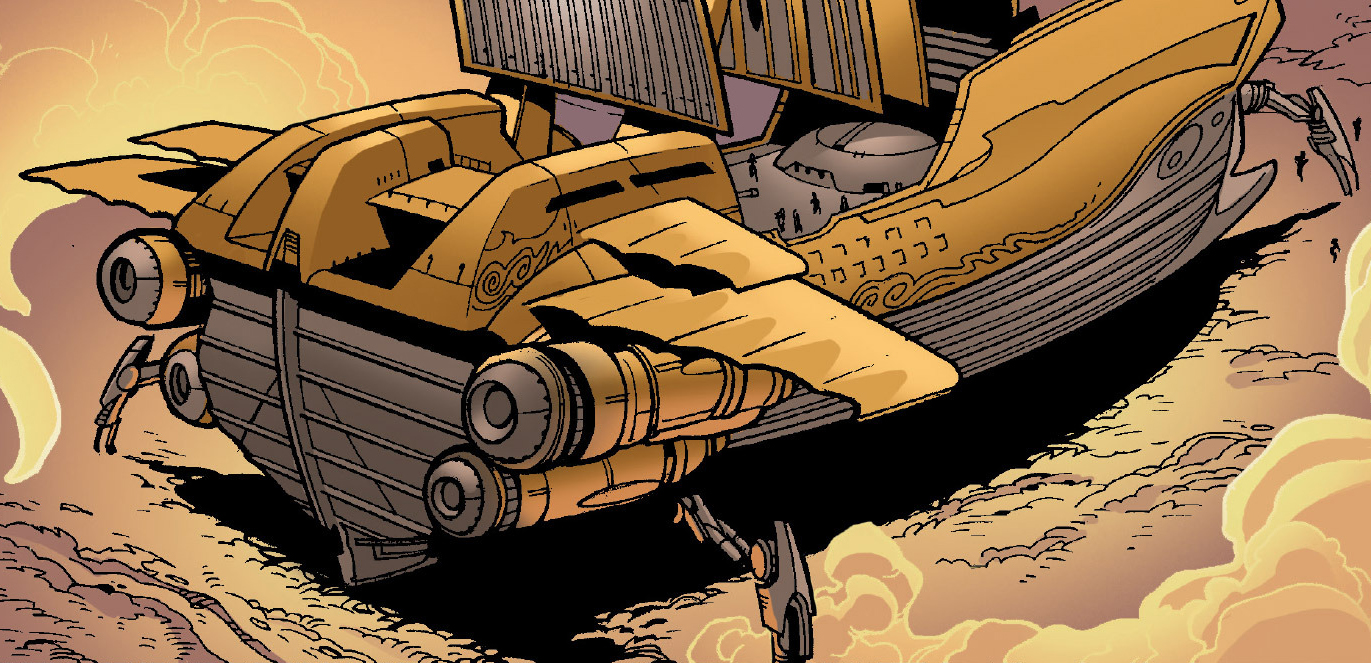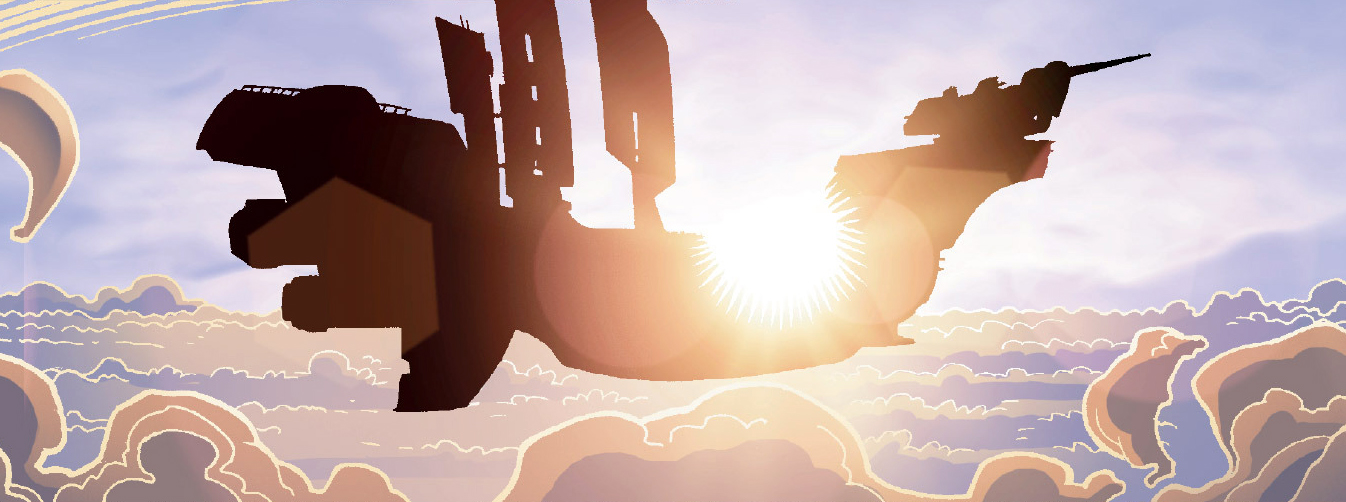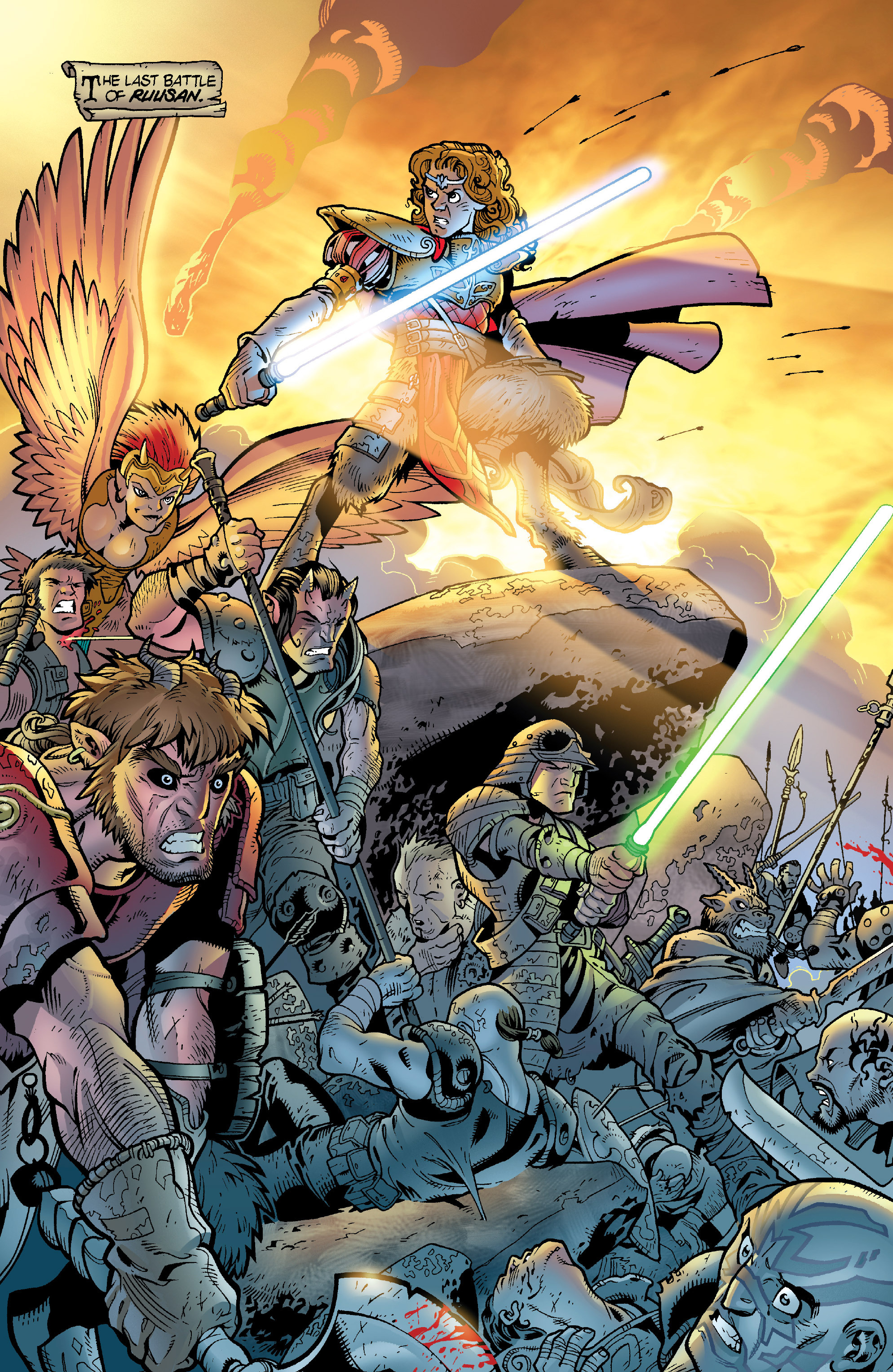The Fairwind was a large gunship of a design reminiscent of large sailing ships. The vessel was built with a rounded hull, twin masts, wings, and a large figurehead. When the ship flew in atmosphere, its upper surface operated as an open-air deck. The heavily-armed Fairwind sported three double-barrelled laser cannons and two laser turrets. Its wooden hull was covered with deflector shield skins.
The Fairwind was owned by Jedi Lord and Master Valenthyne Farfalla. Farfalla used the vessel in his fleet while recruiting Jedi Knights to join with Lord Hoth and his Army of Light on Ruusan during the New Sith Wars. After gathering together three hundred Knights, Farfalla returned to the planet with his starship and a number of other gunships. However, a Sith blockade prevented him from reuniting with Lord Hoth until treachery within the Sith ranks created an opening for the armada.
Farfalla broke through the blockade, rescuing Lord Hoth and his forces in a crucial intervention that helped turn the tide of the war. Hoth's forces were replenished, and the desperate Sith Lord Skere Kaan activated a thought bomb, which ultimately decimated both the Jedi and Sith's ranks on Ruusan. The war came to a end, and in the battle's aftermath, Farfalla led rescue missions from the Fairwind in an effort to recover Jedi survivors.
The Fairwind was a space gunship, with an unusual design that resembled a giant sailing ship replete with multiple masts and a rounded hull. The gunship was timber framed, with a golden keel running down its center. Mounted on the stern were four circular engines, arranged two on each side. Situated above the engine housings were two wings on each side of the hull, one larger and one smaller. When landing, two struts extended from the rear of the hull and one from the bow in order to stabilize the ship as it sat on the ground. Passengers were then able to disembark through a hatchway that extended from the front of the hull.

The stern of Farfalla's flagship.
Above the midline, two rows of portholes ran along the side of the vessel: nine along the upper level, and seven along the lower. When the Fairwind was traveling within an atmosphere, these portholes could be opened to allow fresh air to be let in. Mounted on the front of the ship was a large figurehead, resembling the head and front legs of a horned horse.
The upper surface of the ship operated as an open air deck within an atmosphere, offering unrestricted views to crew and passengers while the ship cruised. Two large masts rose from the deck, topped with circular watch towers. Two broad, though seemingly rigid sails were mounted to each of the masts, and a red pennant flew atop each watchtower. Both of the sails were gold, matching the color scheme of the rest of the ship. In front of these two sails was a smaller third sail: this one colored purple, with a large golden crest emblazoned upon it.
Despite its ornate design, the Fairwind was heavily armed. Each side of the ship was equipped with at least three double-barreled laser cannons: two mounted near the bow and one towards the stern. In addition to these, two laser turrets were incorporated into the figurehead, and another was placed at the leading edge of the bow. The gunship was protected by hulls constructed of the strong and flexible wroshyr tree of Kashyyyk, covered with deflector shield skins.
While the Fairwinds design differed fundamentally from orthodox construction, it was not unique. Similar designs appeared sporadically throughout the galaxy: notable examples included Tof starship design, as exemplified by the Merriweather, and also the flagship of Reddjak the pirate.
The Fairwind featured significantly in the Ruusan campaign at the close of the New Sith Wars. The New Sith Wars were a conflict on a galactic scale which pitted a resurgent New Sith Empire against the Galactic Republic and its ally the Jedi Order. After the Sith forces drove the Republic back, threatening even Coruscant, the Jedi Order prioritized defeating actual Sith Lords over their regular forces. To achieve this end, the Jedi and the Sith engaged in a drawn-out campaign on the planet Ruusan. One of the Jedi Masters fighting there was Lord Farfalla, who had been with the Army of Light since the start of the campaign. A scion of a noble Jedi family, which was a newly part of the Galactic Republic, Farfalla volunteered to recruit reinforcements for the beleaguered Jedi forces on Ruusan.
Farfalla returned to Ruusan months later spearheading a private army and a fleet of ships from his iconic flagship. Each ship in this fleet—composed of a number of capital ships and other massive gunships—was marked with his personal colors. The fleet carried three hundred Jedi Knights he had gathered to the cause, composed of many different species. En route to Ruusan, the task force had fought and defeated the traitorous King Lahzar, finally returning to the Ruusan system to be confronted with a powerful Sith blockade preventing access to the planet.

The Fairwind cruises the atmosphere of Ruusan.
Despite the inability to disembark wholesale on the planet's surface, Farfalla did manage to slip some smaller ships down to the planet, rescuing one of Lord Hoth's caravans from a Sith ambush. However, the blunt general rebuffed Farfalla's aid, stung by the death of Pernicar, his closest companion, during the skirmish. Infuriated, Farfalla returned to his flagship in orbit, leaving Hoth's forces on the surface.
However, the frosty standoff between the two Jedi Masters was healed by the initiative of one of Farfalla's subordinates, who posed as an envoy from Farfalla. Apologizing for the delay in her Lord's return to Ruusan, she elicited a return apology from Hoth. With this rift healed, Farfalla's forces still needed an opportunity to pierce the Sith blockade. An opportunity arose during the next confrontation between the ground forces when a section of the Sith blockade moved to engage Farfalla's forces in orbit. Using his capital ships to draw fire from Sith cruisers and Dreadnaughts, Farfalla managed to punch through the blockade with the Fairwind and a number of gunships. These gunships bore down on the ground forces, their laser cannons destroying Sith fliers and routing enemy forces. The outmatched Sith quickly fled the onslaught, giving victory that day to the Jedi. This intervention by the Fairwind proved decisive for the Ruusan campaign and the whole of the New Sith Wars. With Lord Hoth's forces replenished, Lord Kaan, leader of the Brotherhood of Darkness, was forced into a desperate gambit: unleashing a thought bomb to destroy the Jedi. Lord Hoth willingly led one hundred Jedi volunteers to Lord Kaan to stop Kaan or force him to detonate the bomb. Kaan chose the latter, and when the thought bomb was unleashed, both Jedi and Sith forces were destroyed.
Lord Farfalla and his forces survived the detonation, having withdrawn to a safe distance. Farfalla, now the leader of the Army of Light, organized the rest of the Jedi, evacuating Ruusan in his fleet.
After the thought bomb detonated, Farfalla, commanding from the Fairwind, oversaw several rescue missions at Ruusan, hoping that any non-Force sensitive Army of Light survivors could be rallied up. Following the Seventh Battle of Ruusan, survivors were tended to and cured, while enemies, such as mercenaries, were locked up in holding cells.

Crew members of the Fairwind fight on Ruusan.
Lord Valenthyne Farfalla was a half-Bothan alien Jedi Master from a noble family. He favored elaborate etiquette and court ceremony, leading some Jedi to perceive him as foppish and vain, an impression that clung to him long after his death. However, to Jedi that knew him well, Farfalla was highly regarded. He was one of the first Jedi Masters to join Lord Hoth and his Army of Light on Ruusan, and subsequently fought in nearly every confrontation there, earning a fierce reputation even amongst the Sith forces.
Lirondo was a Jedi Knight, and a close companion of the Jedi Master. He traveled on the Fairwind and marshaled its forces for the Seventh Battle of Ruusan. Lirondo fought at his master's side during that battle, wielding a large axe and a green lightsaber.
Also there was a female alien envoy with humanoid and avian characteristics; most notably two large wings. On her own initiative she approached Lord Hoth with an apparent apology from Farfalla. When she returned to Farfalla with an apology from Hoth, he saw through her ruse, yet appreciated the irony of the situation. The envoy fought in the Seventh Battle of Ruusan alongside Lirondo and Farfalla.
Farfalla's flagship first appeared in the comic Star Wars: Jedi vs. Sith, although it went unnamed. It was subsequently referred to in The New Essential Chronology, described as a "wooden-hulled battleship." The events of Jedi vs. Sith were later retold in the novel Darth Bane: Path of Destruction by Drew Karpyshyn. In retelling these events, the author made some changes to the chronology of the Ruusan campaign, as well as other cosmetic changes. Where Farfalla's forces had originally comprised only one ship, he was now given a whole fleet. Furthermore, in order to remove some of the fairytale characteristics of the original comic, Karpyshyn made no reference to the unusual design of the starships, instead referring to them as "gunships."
In order to integrate these two sources, this article has understood the gunships that fulfill the same role as the starship in the original comic to include Farfalla's flagship. The chronology of the novel has also been favored over that of the comic, placing the dramatic intervention of Farfalla's forces after the death of Pernicar, rather than contemporaneous as in the comic.
- The New Essential Chronology
- The Complete Star Wars Encyclopedia
- The Essential Guide to Warfare